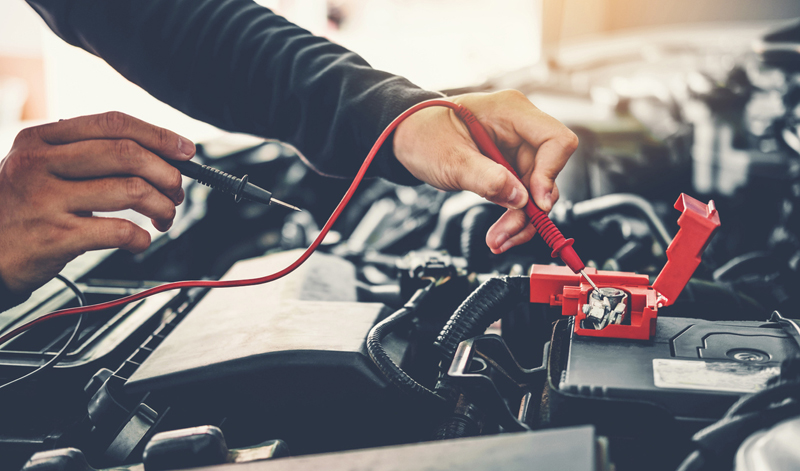As many of us know, a lead acid battery adopts lead and its oxide as the battery plate and sulfuric acid as the electrolyte. A lead acid battery converts chemical energy into electrical energy through a chemical reaction within the battery. The electrical energy will then be transmitted through cables to multiple electrical parts. Lead acid batteries are charged and discharged through electrolyte consisting of sulfuric acid and distilled water. Thus, lead acid batteries can be regarded as small chemical power plants that store electrical energy on their plates. When a lead acid battery is discharged, the positive plate of the battery will react with the sulfuric acid electrolyte to produce lead sulfate. Lead sulfate exists in a soluble, electrically conductive ionic state. When a battery charger is used to charge the battery, the reaction goes the other way. The lead sulfate will react again to form sulfuric acid. This is the ideal phenomenon we are looking forward to. It’s ideal because sometimes it’s not going like that.
Why do some lead acid batteries go wrong?
Sometimes, in the use of lead acid batteries, too much lead sulfate accumulates on the battery plate when the crystal accumulation is too high and the battery is not charged in time. The lead sulfate will bind to the plate, forming an insoluble, insulating layer of macro molecule lead sulfate crystals, which will cause the plate to be unable to fully contact the electrolyte. The problem is that the battery can no longer be charged and discharged properly. The normal lifespan of lead acid batteries is as low as 3-5 years, and that of high-quality types can be more than 10 years. If excessive accumulation of lead sulfate exists for long time without intervention, the accumulation of lead sulfate crystals will accelerate the deterioration of batteries, leading to premature battery failure.

How A Pulse Repair Battery Charger Works
In order to solve the problem of damage or premature failure of lead acid batteries caused by accumulation of lead sulfate, adopting pulse repair battery charger is a simple and efficient method. Pulse repair battery chargers use the principle that any insulating layer can be broken down at a certain high voltage. By applying instantaneous high voltage to lead sulfate crystal in a lead acid battery, the insulation layer of lead sulfate can be broken down, and thus the contact between the plate and the electrolyte can be recovered. In this way, the normal charging and discharging function of the battery will be restored.
Battery Charger with Microcomputer Pulse Repair Function
Our Microcomputer Pulse Repair Battery Charger has intelligent recognition and pulse repair functions, which make it a good assistant for your lead acid battery recovery work. The product can effectively remove the lead sulfate from your lead acid batteries. It has a significant effect to restore your battery capacity. It can be widely used for automobile lead acid battery, motorcycle lead acid battery, ATV lead acid battery and motorboat lead acid battery repair.
Attention Points
Different from the general lead acid battery chargers, a pulse repair battery charger has its certain requirements for battery types, location and time length of the repair process. For detailed information, you can go to … for reference.
The following are some tips for better use and maintain your lead acid batteries in your daily use.
Tips for Use and Maintenance of Lead Acid Batteries
- Even for some maintenance-free lead acid batteries, regular check and maintenance are still necessary.
- Avoid long-term low capacity in lead acid batteries. Remember to replenish distilled water in time. Ensure that the sulfuric acid content in the electrolyte is about 22-28%.
- Avoid overcharging to your batteries. We have talked about the overcharging of lead acid batteries in our previous blog. You can go to On Lead Acid Battery Overcharging.
- It is distilled water that should be added when the electrolyte level of your lead acid battery is low. Do not replace distilled water with electrolyte which contains sulfuric acid. Otherwise, it will increase the concentration of the battery electrolyte, leading to the possibility of electrolyte boiling or the occurrence of acid fog, which will seriously affect your battery’s lifespan. At the same time, purified water for drinking should not be used either. This is because it contains microelements, which can cause adverse effects on your batteries.
- The ideal charging temperature condition for a lead acid battery is around 25℃. When it is below 15 ℃, its capacity will decline sharply to 2/3 of its original level. If it is below 0℃, its capacity will decline further. Therefore, when you charge your lead acid battery in winter, you’d better choose to do it indoors for the protection of the battery.

